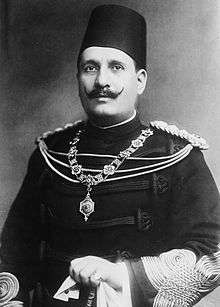King of Egypt
King of Egypt (Arabic: ملك مصر Malik Miṣr) was the title used by the ruler of Egypt between 1922 and 1951. When the United Kingdom ended its protectorate over Egypt on 28 February 1922, Egypt's Sultan Fouad I issued a decree on 15 March 1922 whereby he adopted the title of King of Egypt. It has been reported that the title change was due not only to Egypt's newly independent status, but also to Fouad I's desire to be accorded the same title as the newly installed rulers of the newly created kingdoms of Hejaz, Syria and Iraq.[1] The only other monarch to be styled King of Egypt was Fouad I's son Farouk I, whose title was changed to King of Egypt and the Sudan in October 1951 following the Wafdist government's unilateral abrogation of the Anglo-Egyptian Treaty of 1936.[2] The monarchy was abolished on 18 June 1953 following the Egyptian Revolution of 1952 and the establishment of a republic. The then-king, the infant Fuad II of Egypt (Farouk having abdicated following the revolution), went into exile in Switzerland.
| Malik of Egypt | |
|---|---|
 | |
 | |
| Details | |
| Style | His Majesty |
| First monarch | Fouad I |
| Last monarch | Fouad II |
| Formation | 15 March 1922 |
| Abolition | 18 June 1953 |
| Residence | Abdeen Palace, Cairo, Egypt |
| Appointer | Hereditary |
| Pretender(s) | Fuad II |
The rulers of ancient Egypt may be described using the title King (a translation of the Egyptian word nsw) or Pharaoh (derived from pr ˤ3).
See also
- Pharaoh
- List of pharaohs
- List of monarchs of the Muhammad Ali Dynasty
- Lists of rulers of Egypt
References
- Rizk, Yunan Labib (10–16 February 2000). "The fallen dynasty". Al-Ahram Weekly (468). ISSN 1110-2977. OCLC 163624446. Archived from the original on 20 July 2008. Retrieved 2008-08-02.
- "Egypt: On the Threshold of Revolution, 1945-52". Country Studies. Federal Research Division of the Library of Congress. December 1990. Retrieved 2008-08-23.
.svg.png)